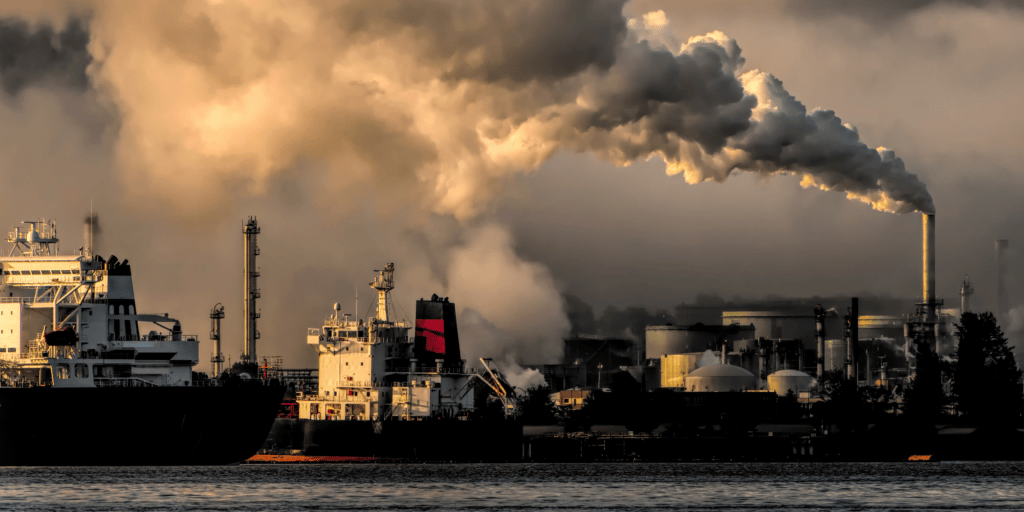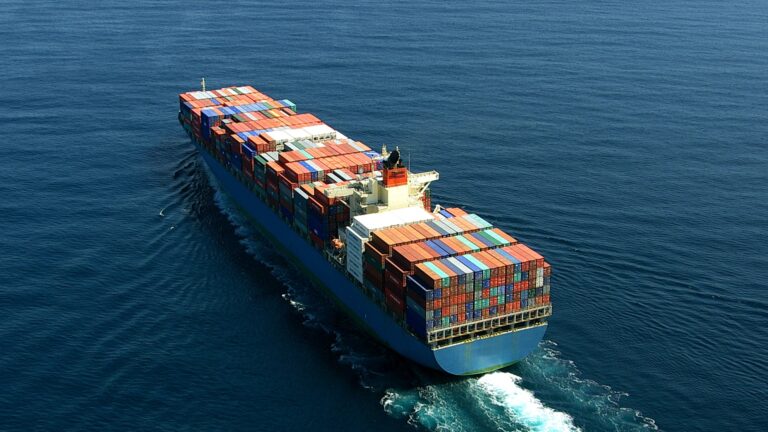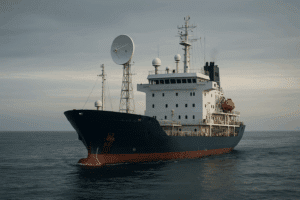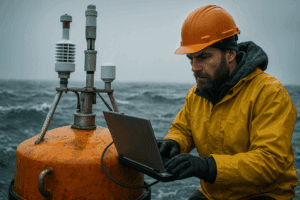Becoming sustainable is one of the main challenges faced by the shipping industry. As a matter of fact, more than three percent of global greenhouse gas (GHG) emissions are attributed to the sea transportation sector. And since it serves more than 90% of the world’s trade, while the demand is increasing rapidly, it has to quickly reduce its carbon footprint. The IMO is coordinating all stakeholders’ efforts towards that goal.
Why is carbon footprint reduction a major concern for the shipping industry?
Although it is a critical pillar of the global economy, the shipping industry is very polluting. Moving such amount of goods around the globe leads requires roughly 300m metric tons of dirty fossil fuels per year. This process generates approximately 1bn metric tons of carbon dioxide emissions. This is quite as much as some countries’ annual greenhouse gas emissions if only to mention Japan. According to the International Maritime Organization (IMO), the emissions from merchant’s vessels might be 30% above their 2008 levels.
That is the reason why one of the IMO’s main concerns is the prevention of pollution from ships and the fight against climate change. As a reminder, this United Nations body that regulates shipping also deals with safety and security for ships and people, professional training for workers, and labor regulation.
What are the IMO’s priorities from an environmental perspective?
Monitoring and improving ships’ energy efficiency
For a sustainable change in a ship’s energy efficiency, regulations have to be stricter compared to the IMO’s primary energy efficiency regulation for ships populated in 2011, about the minimum fuel efficiency needs per mile covered. The ultimate goal of all initiatives is to reach its intention of a 40% decrease in carbon dioxide emissions – in contrast with 2008 levels – by 2030.
Important challenges for the international shipping business are seen through the amendments to Annex VI of the International Convention for the Prevention of Pollution from Ships (MARPOL), ratified in June 2021 by the 76th Marine Environmental Protection Committee (MEPC) summit.
As an example, tests will be conducted for exhaust emissions for all vessels recorded on the MARPOL’s list of member countries starting from January 1, 2023. The scaling will be done using Energy Efficiency Existing Ship Index (EEXI) and will be mandatory for all vessels of 400 gross tonnages (GT) or more. A given ship’s carbon production will have to reach the goals shared by the EEXI during testing time, for it to be awarded the certificate of compliance, labeled the International Energy Efficiency Certificate (IEEC).
As per EEXI standards, vessels will be examined on an emissions scale of A to E. Vessels in the A to C pool will be granted an IEEC. The others falling into the D and E pools needs further efforts to receive the credentials. The ship owners will have to declare a set of actions that their ship will undertake to reach a range of A to C grades on energy efficiency. For those that remain rate D or E rating for three consecutive years, shipping companies will have to share a “corrective action plan” in order to attain the A-E ladder.
Besides, the Energy Emissions Design Index (EEDI) regime for ships under construction is still in force since its implementation in 2013.
Tightening regulations
Nonetheless, other measures may be required, as the European Union (EU) specified recently that for all ships docking in ports or cruising within its waters, a 55% reduction in carbon emissions, compared to 1990 levels, will be mandatory by 2030. Europe is setting the tone by regulating vessels’ emissions by using its emissions trading system, with a starting period in early 2023. Under the projected law, shipping corporations will be demanded to pay for the carbon emitted by their fleets for any travel to and from the EU and between European ports around 2026.
In another hand, the EU is suggesting a fuel mandate that would induce the business to use a gradually greater share of low- and zero-carbon fuels in its vessels. And in April 2022, the United States agreed to seek a zero-emission shipping industry by 2050. An ambitious action plan is under construction and shall be driven by the maritime transport business representatives, along with the US Environmental Protection Agency (EPA).
Besides, the International Chamber of Shipping brought forward a carbon levy of $2 a metric ton of fuel to be allocated to research and development of clean shipping technology. This suggestion, together with another determined proposal by the Marshall Islands to tax merchant vessels to a standard of $100 a metric ton of bunker fuel.
The ICS, for the moment, cannot confirm if the trade would agree on the specific fuel tax suggested by the Marshall Islands. But a debate about market-based measures is welcome to bring down emissions and reach low and zero carbon synthetic fuels to reach its zero emissions objective that double the ambitions of the IMO.

Use of alternative fuels
Aware of growing environmental alarms, vessel builders and owners are considering alternative energy sources for their fleets. Scientists have predicted that if zero-emissions fuels cover 5% of the international shipping fuel mix by 2030, the industry will be on track to totally decarbonize by 2050. The Global Maritime Forum Getting to Zero Coalition trusts that the goal is achievable following recently proclaimed plans, counting in the EU’s 2020 Hydrogen Strategy, which demands building at least 40 gigawatts of renewable hydrogen electrolyzers by 2030 altogether with China and Japan’s intentions to maximize hydrogen fuel production.
International shipping business research and developments are focusing on liquid natural gas (LNG), liquefied petroleum gas (LPG), hydrogen, ammonia, methanol, or even solar energy to decrease their environmental impacts. Though, engines will need modifications to be able to use them, even as dual fuels. To get by sourcing issues, these substitutes can be blended with heavy fuel oil (HFO) or very low-sulfur fuel oil (VLSFO) to be able to catch fire within the vessel engine cylinders.
However, such transformation comes with a number of issues related to quality, safety, and reliability for use on commercial vessels, scaling and broad deployment, costs, and availability, among others:
- While the industry’s attention has been on sulfur and carbon emissions from commercial ships, other issues appear on the horizon, like nitric oxide (NOx) or the particulate matter emissions (PM) from some of the proposed alternative fuels.
- The zero-carbon fuels have to be widely available with the needed infrastructure so that vessel operators can easily use them. Hydrogen, in particular, has a very low energy density as opposed to oil, meaning that any ship using it, in order to stabilize, has to carry much higher volumes of fuel or be replenished more often.
- Ammonia is toxic to humans and marine life, thus raising safety and environmental alarms.
- While green methanol can be directly released into existing ships with lower retrofits, hydrogen or ammonia will need more modifications to the existing engines and machinery, even for those who use dual fuels.
- Vessel crews need to be proficient in handling these new sources of energy, as ammonia is more corrosive and minor errors could be fatal.
- No international quality standards are available at the moment for alternative fuels for ships. Generally speaking, IMO has to push further for cross-country climate regulations, because according to some experts, the history of IMO regulations shows that “this United Nations organization has acted because the EU or the United States have acted on their own”.
Optimization of fuel consumption
Fuel consumption can also be managed by using technology as already done by the biggest shipping companies on their fleets. To do so, they rely on modern technologies, just to name artificial intelligence, Big data, and the Internet of Things. Historical and real-time data gathered from sensors placed on the ships, information from satellite observation, and other sources are compiled and analyzed in order to determine the best routes and recommendations for speed, maneuvering, etc. This process reduces fuel consumption and lessens greenhouse gas emissions into the atmosphere. AI-based powerful solutions also allow modeling from existing values in order to take mid-term or long-term measures in order to continuously lower the industry’s carbon dioxide emissions.
Slow steaming is another cost-effective approach to consume less fuel and contribute to climate change mitigation. Capping speed results in a significant reduction of air pollution from shipping. The proposal to apply speed restrictions to merchant’s vessels in order to cut GHG and other pollutants emissions first came from the Clean Shipping Coalition (CSC) in September 2010 at the IMO’s Marine Environment Protection Committee (MEPC 61). The industry only started considering slow steaming after receiving the results of a study led by two of the CSC members regarding the legal, environmental, and economic feasibility of regulated slow steaming. Now, all agree that the practice has multiple environmental benefits while contributing to cost cut, and GHG emissions reduction. It appears that a ship’s speed reduction of 25% allows a 58% decrease in its main engine fuel consumption on a yearly basis and lessens the associated emissions of carbon dioxide, SOx, and Nox.

Monitoring underwater noise
Lowering the shipping industry’s environmental impact is not only about air pollution. Reducing underwater noise effects on the marine ecosystem is also a major challenge for the sector to improve its sustainability.
Multiplies of international bodies led by IMO are involved in order to minimize anthropogenic acoustic disturbances from ship traffic and operations, including the MEPC and the Maritime Safety Committee (MSC). Since 2011, Marine Directors in European Union (EU) Member States follow the guide issued by the Technical Subgroup on Underwater Noise to set up monitoring schemes in their waters, in compliance with the Marine Strategy Framework Directive. Scientists have set the background level of undersea noise at 80 dB re 1 μPa at low frequencies (between 100 Hz to 1,000 Hz). Therefore, ship builders and shipping companies have to maintain their vessels’ noise emissions under that limit to avoid harming marine animals. However, the road ahead is still long since actual levels are said to be around 80 and 110 dB re 1 μPa.
Innovative methods using new technologies have been developed to measure noise levels of merchant’s vessels to enable effective decision-making so as to lessen the overall amount of noise undersea. Information transmitted by connected underwater sound recording (USR) devices is associated with data provided by dedicated tools. As an example, Sinay’s IA-based calculator provides an estimation of the Sound Exposure Level (SEL) of any vessel type and journey anywhere in the world. An API facilitates the solution’s integration into any company’s own platform to help it assess its underwater noise impact and compliance with industry standards. This indicator is then used as a basis to adapt its vessel’s characteristics and its way of working.
Conclusion
The shipping business is trying its best to regulate and fix issues from its carbon footprint. However, there is still much to do to better exploit the opportunities offered by greener energy, new technologies, and reinforced regulation. Observers assign this gap partly to IMO’s slow procedures, where industry representatives serve on state delegations. Tough decisions have to be taken by the IMO and its stakeholders to align with the Paris agreement objectives. It is safe to assume that there will be more rigorous upcoming rules to reach the reduction targets set, as the sea transportation sector strives to attain a satisfactory environmental value.
Frequently Asked Questions About Sustainable Shipping
The main environmental challenge faced by the shipping industry is the reduction of its carbon footprint. The shipping industry contributes to more than three percent of global greenhouse gas emissions.
The shipping industry contributes to global greenhouse gas emissions by using roughly 300 million metric tons of dirty fossil fuels per year to move goods around the globe, which generates approximately 1 billion metric tons of carbon dioxide emissions, roughly the same as some countries’ annual emissions.
The International Maritime Organization plays a crucial role in promoting sustainability in the shipping industry by coordinating all stakeholders’ efforts to reduce the sector’s carbon footprint and prevent pollution from ships, as well as by regulating safety and security for ships and people, professional training for workers, and labor regulations.
The IMO has also committed to cutting greenhouse gas emissions at least in half by 2050 to comply with the Paris Climate Agreement’s 1.5C global heating target.
The IMO plan to reduce the sector’s carbon footprint by at least 50% by 2050 by implementing stricter regulations and initiatives to monitor and improve ships’ energy efficiency.
This includes amendments to Annex VI of the International Convention for the Prevention of Pollution from Ships (MARPOL), using the Energy Efficiency Existing Ship Index (EEXI) and Energy Emissions Design Index (EEDI) regimes, and enforcing a “corrective action plan” for ships that remain at a low energy efficiency rating for consecutive years.
The specific regulations and initiatives the IMO has implemented to improve ships’ energy efficiency include:
- Amendments to Annex VI of the International Convention for the Prevention of Pollution from Ships (MARPOL)
- Mandatory testing for exhaust emissions for all vessels on the MARPOL’s list of member countries starting from January 1, 2023, using the Energy Efficiency Existing Ship Index (EEXI)
- The Energy Emissions Design Index (EEDI) regime for ships under construction
- Enforcement of a “corrective action plan” for ships that remain at a low energy efficiency rating for consecutive years.
- The IMO also set an ultimate goal of a 40% decrease in carbon dioxide emissions – in contrast with 2008 levels – by 2030.
These regulations and initiatives are intended to have ships operate more efficiently and emit fewer greenhouse gases, which will help reduce the carbon footprint of the shipping industry.
Focus on data to make effective decisions
Discover our modules
Environmental Monitoring
Monitor air quality in real-time, be alerted when a threshold is reached & easily comply with regulation thanks to the automated reports.
Monitor water quality in real-time, predict and avoid water pollution & comply with regulations thanks to the automated reports.
Deliver a preliminary metocean analysis and the associated report in jut a few minutes.
You may also be interested by those others environment application :


